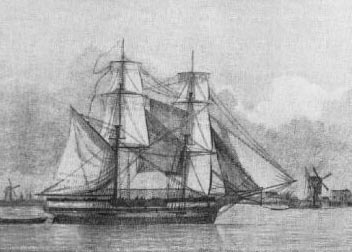
YOU ARE HERE: home>>discovery >> lady nelson

LADY NELSON, the
name of a 60-ton brig which for 25 years had an important
part in the early history of Australia.
Built
at Deptford, England, in 1799,
she had a centre-board keel invented by
Captain
Schank, and as she made her
way down the Thames, sailors on vessels
on
the river ironically christened her
"His Majesty's Tinder box".
Many
doubted that she would
ever make her port of destination.
With Lieut. James Grant as commander, the
Lady
Nelson left England for Australia
in March 1800. She was the first vessel
to
sail parallel to the entire southern
coast of Australia, and was the first to
sail
eastward through Bass Strait.
She charted the coastline of Victoria,
explored
its inlets, and penetrated its
rivers.
She
travelled north to Moreton
Bay, Port Essington and Melville Island, and also
helped to establish Lieut. Bowen's colony
at Risdon Cove, Tasmania.
From September 1801 to March 1803 she was
commanded by Acting Lieut. John Murray,
she was used in the discovery of the Port
Phillip district and the surveying of much of
Bass Straight. During which time the
Danish
adventurer Jorgen Jorgensen served in her as
'second mate'.
She
played many parts in
the early history of Australia, now acting as Governor King's
messenger and carrying dispatches to
Norfolk
Island, fetching grain from the
Hawkesbury or coals or timber from
Newcastle,
and at another time carrying troops
and settlers to the far north. She also
conveyed
bricks from Sydney kilns to Tasmania
and New Zealand to build the homes of the
first white settlers in those lands.
For a
time the Lady Nelson
was dismantled, but she returned to service later.
In February 1825 she was dispatched to
northern
islands for a cargo of buffaloes,
and her crew were warned to avoid Baba
Is.,
northeast of Timor. The warning appears
to have been disregarded; consequently
the
ship was attacked by island savages,
the crew were murdered and the vessel was
run ashore; her hull was seen later on the
island with her name still visible.
Lady
Nelson's Point, Lady
Nelson's Reef and Cape Nelson on the south coast of
Australia, and Mount Nelson, Tasmania,
commemorate
the vessel.